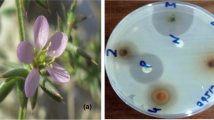Abstract
The rapid proliferation of antibiotic-resistant microbes has imposed an urgent need for development of novel antimicrobial agents with diverse mechanisms. This study reports a novel extraction method with salting-in and salting-out method for obtaining potential bacteriocin from Bacillus subtilis (MK733983) of ethnomedicinal origin. This technique extracted bacteriocin with desired antimicrobial peptide moieties that showed creditable minimum inhibitory concentrations, thermostability and efficacy compared to all other extraction protocols attempted. Further study used a unique scheme of steps in RP-HPLC purification process using methanol—water as solvents for the bacteriocin that achieved an outstanding antimicrobial activity against Staphylococcus aureus (MTCC 737). The bacteriocin is sensitive to proteases, confirming its proteinaceous nature and showed promising heat stability up to 70 °C for 10 min. Bacteriocin extracted from a series of ammonium sulphate precipitation showed MIC values 350 µg and 300 µg for Mycobacterium smegmatis and Staphylococcus aureus respectively. On the other hand, bacteriocin extracted by using chloroform showed MIC values 400 µg and 300 µg for M. smegmatis and Staphylococcus aureus. All the results implicate the efficacy of bacteriocin and future prospect as an effective antimicrobial agent.





Similar content being viewed by others
References
WHO Report (2020) https://www.who.int/news-room/fact-sheets/detail/antimicrobial.resistance. Accessed 31 July 2020.
Roberts SC, Zembower TR (2020) Global increases in antibiotic consumption: a concerning trend for WHO targets. Lancet Infec Dis 21:10–11
Green AA, Hughes WL (1955) Protein solubility on the basis of solubility in aqueous solutions of salts and organic solvents. Methods Enzymol 1:67–90
Huan Y, Kong Q, Mou H, Yi H (2020) Antimicrobial peptides: classification, design, application and research progress in multiple fields. Front Microbiol 11:582779. https://doi.org/10.3389/fmicb.2020.582779
Burianek LL, Yousef AE (2000) Solvent extraction of bacteriocins from liquid cultures. Lett Appl Microbiol 31:193–197
Joseph B, Dhas B, Hena V, Raj J (2013) Bacteriocin from Bacillus subtilis as a novel drug against diabetic foot ulcer bacterial pathogens. Asian Pac J Trop Biomed 3:942–946. https://doi.org/10.1016/S2221-1691(13)60183-5
Santhi SS, Aranganathan V (2020) Bioprospecting of some ethnomedicinal plants for potential antimycobacterial bacteriocin like inhibitory substances (BLIS). Explor Anim Med Res 9:180–187
Anand TP, Bhat AW, Shouche YS, Roy U, Siddharth J, Sarma SP (2006) Antimicrobial activity of marine bacteria associated with sponges from the waters off the coast of South East India. Microbiol Res 2005:252–262
Lee SG, Chang HG (2018) Purification and characterization of mejucin, a new bacteriocin produced by Bacillus subtilis SN7. LWT Food Sci Technol 87:815
Santhi SS, Aranganathan V (2021) Bio-profiling of a potential antimycobacterial bacteriocin produced by Bacillus subtilis (MK733983) of ethnomedicinal origin. J Microbiol Biotechnol Food sci. https://doi.org/10.15414/jmbfs.3259
Meyer FM, Jules M, Mehne FM, Le, Coq D, Landmann JJ, Görke B, Aymerich S, Stülke J (2021) Malate-mediated carbon catabolite repression in Bacillus subtilis involves the HPrK/CcpA pathway. J Bacteriol. https://doi.org/10.1128/jb.06197-11
Nakano MM, Zuber P (1990) Molecular biology of antibiotic production in Bacillus. Crit Rev Biotechnol. https://doi.org/10.3109/07388559009038209
Cheng M, Gong SG, Lévesque CM (2020) Rapid isolation and purification of secreted Bacteriocins from streptococcus mutans and other Lactic Acid Bacteria. Bio-Protocol. https://doi.org/10.21769/BioProtoc.3824
Sahar A, Joo ST, Tengku ATI, Fatemeh B, Nagasundar RR, Shuhaimi M, Arbakariya BA (2017) Fermentation factors influencing the production of bacteriocins by lactic acid bacteria: a review. RSC Adv 7:29395–29420. https://doi.org/10.1039/C6RA24579J
Gao FH, Abee T, Konings WN (1991) Mechanism of action of the peptide antibiotic nisin in liposomes and cytochrome c oxidasecontaining proteoliposomes. Appl Environ Microbiol 57:2164–2170. https://doi.org/10.1128/AEM.57.8.2164-2170.1991
Santhi SS, Aranganathan V (2021) Experimental elucidation of an antimycobacterial bacteriocin produced by ethnomedicinal plant-derived Bacillus subtilis (MK733983). Arch Microbiol. https://doi.org/10.1007/s00203-020-02173-7
WHO, Antibacterial agents in clinical development: an analysis of the antibacterial clinical development pipeline, including tuberculosis. Geneva: World Health Organization (WHO/EMP/IAU/2017.12), 2017.
Agrawal A, Miryala S, Varshney U (2015) Use of mycobacterium smegmatis deficient in ADP Ribosyl transferase as surrogate for mycobacterium tuberculosis in drug testing and mutation analysis. PLOS One 10:e0122076. https://doi.org/10.1371/journal.pone.0122076
Acknowledgements
The authors wish to express their sincere gratitude and recognition for assistance from Dr. Salamun (with RP-HPLC) of Department of Biotechnology, Jain (Deemed to-be) University. The authors have filed a patent in Indian patent system with the subject matter or materials discussed in the manuscript. Indian Patent Application Number: IN202241002985; Title of the Invention: ‘Method for Extraction and Purification of bacteriocin from Bacillus subtilis’, we acknowledge Jain (Deemed-to-be University).
Funding
This research did not receive any specific grant from funding agencies in the public, commercial, or not-for-profit sectors.
Author information
Authors and Affiliations
Corresponding author
Ethics declarations
Conflict of interest
The authors declare no conflict of interest; Ethical approval: Not Applicable.
Consent to Participate
The authors give their consent to participate.
Consent for Publication
The authors give their consent for publication.
Additional information
Publisher's Note
Springer Nature remains neutral with regard to jurisdictional claims in published maps and institutional affiliations.
Rights and permissions
Springer Nature or its licensor (e.g. a society or other partner) holds exclusive rights to this article under a publishing agreement with the author(s) or other rightsholder(s); author self-archiving of the accepted manuscript version of this article is solely governed by the terms of such publishing agreement and applicable law.
About this article
Cite this article
Sudha, S.S., Aranganathan, V. Efficacious Extraction and Purification Technique of a Potential Antimycobacterial Bacteriocin Produced by Bacillus subtilis (MK733983) of Ethnomedicinal Origin. Indian J Microbiol 63, 668–676 (2023). https://doi.org/10.1007/s12088-023-01128-y
Received:
Accepted:
Published:
Issue Date:
DOI: https://doi.org/10.1007/s12088-023-01128-y




